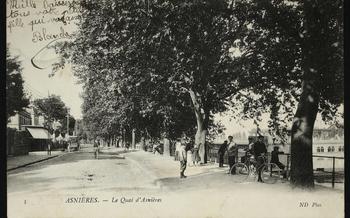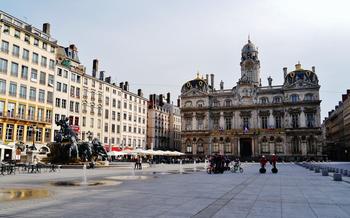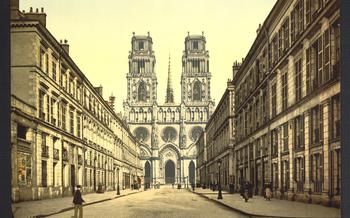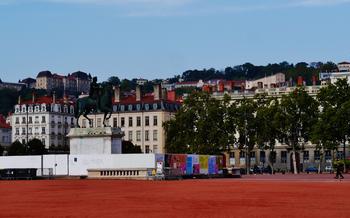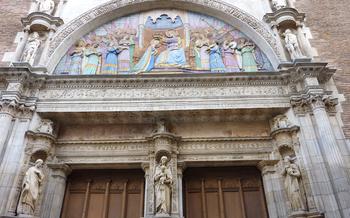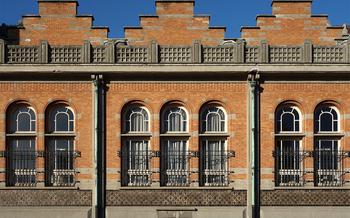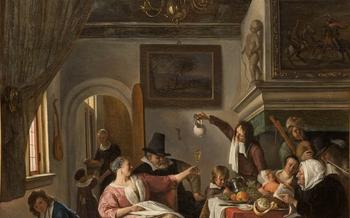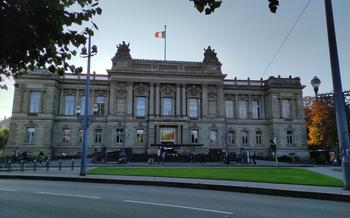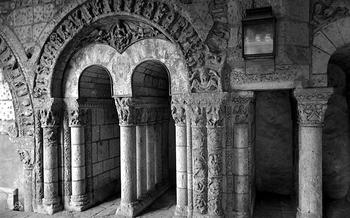
Chapelle du Carmel
- Historical Background
- Location and Accessibility:
- Architectural Features
- Religious Significance
- Chapelle du Carmel Museum
- Music and Cultural Events
- Visiting Hours and Admission:
- Guided Tours
- Accessibility for Visitors with Disabilities
- Photography and Videography
- Surrounding Attractions:
- Local Cuisine and Dining Options:
- Accommodation Options:
- Shopping and Souvenirs:
- Insider Tip:
Historical Background
The Chapelle du Carmel, a testament to faith and architectural prowess, stands as a cherished landmark in Tourcoing. Built in the 18th century, its foundations are steeped in the rich history of the Carmelite order, a religious community renowned for their devotion to prayer and contemplation. The Carmelites, seeking a sanctuary for their spiritual practices, found solace within these walls, transforming the chapel into a sacred space dedicated to their unwavering faith.
As the French Revolution swept across the nation, the Chapelle du Carmel faced an uncertain fate. The tumultuous events of that era threatened its very existence, yet it miraculously survived, emerging as a symbol of resilience and enduring faith. Its architectural style, a harmonious blend of Gothic and Renaissance elements, reflects the diverse influences that shaped its construction, showcasing the artistic sensibilities of its time. Recognized as a historical monument, the chapel stands as a testament to the cultural and architectural heritage of Tourcoing, inviting visitors to explore its captivating past and immerse themselves in its sacred atmosphere.
Location and Accessibility:
The Chapelle du Carmel is conveniently located at 102 Rue du Carmel in Tourcoing, France. Its proximity to the city center makes it easily accessible on foot, allowing visitors to explore the vibrant streets and landmarks of Tourcoing before or after their visit to the chapel. For those arriving by public transportation, the closest bus stop is "Carmel," served by lines 12 and Ample parking is available in the vicinity of the chapel, ensuring a hassle-free visit for those traveling by car.
Architectural Features
The Chapelle du Carmel boasts a striking facade that captivates visitors with its intricate carvings and decorative elements. The Gothic-inspired pointed arches, buttresses, and pinnacles lend a sense of grandeur to the exterior, while the Renaissance-style ornamentation adds a touch of elegance and sophistication. Step inside the chapel, and you'll be awed by the vaulted ceilings, supported by graceful columns and adorned with intricate ribbed patterns. The stained glass windows, with their vibrant colors and biblical scenes, cast a warm and ethereal glow upon the interior, creating a truly inspiring atmosphere.
The chapel's unique design is a testament to the architectural prowess of its era. Its harmonious blend of Gothic and Renaissance elements showcases the transition between two significant periods in European history. Visitors can't help but marvel at the attention to detail and the craftsmanship that went into every aspect of the chapel's construction, from the intricate carvings on the facade to the delicate stained glass windows. Ongoing restoration and conservation efforts are underway to preserve the chapel's grandeur and ensure that it continues to captivate visitors for generations to come.
Religious Significance
The Chapelle du Carmel holds immense religious significance as a place of worship for the Carmelite order, a Catholic religious order known for their dedication to prayer and contemplation. The chapel serves as a sacred space where the Carmelites gather to engage in various religious ceremonies and rituals, including daily masses, prayer services, and special devotions.
Throughout its history, the chapel has been a place of pilgrimage, attracting devotees from near and far who seek solace, spiritual guidance, and a deeper connection with the divine. Visitors to the chapel can experience the serene and contemplative atmosphere that permeates the space, making it an ideal place for reflection and spiritual renewal.
The chapel is also associated with unique religious traditions and customs that have been passed down through generations. These traditions include the veneration of specific saints and relics, as well as the celebration of special feast days and processions. Visitors are encouraged to learn about these traditions and participate in them, gaining a deeper understanding of the rich spiritual heritage of the chapel and the Carmelite order.
Chapelle du Carmel Museum
Delve into the rich history and heritage of the Chapelle du Carmel at its onsite museum. This treasure trove of artifacts, documents, and artwork provides a deeper understanding of the chapel's past and enduring legacy. Through engaging exhibits and displays, visitors can explore the lives of the Carmelites, their spiritual practices, and the chapel's role in the community. Discover the stories behind the chapel's construction, its architectural evolution, and the significant events that have shaped its history. The museum offers a unique glimpse into the world of the Carmelites and their unwavering commitment to prayer and contemplation. Guided tours are available to enhance the museum experience, providing expert insights and personalized commentary. Admission fees are minimal, and special events and workshops are organized throughout the year. Whether you're a history buff, an art enthusiast, or simply curious about the chapel's heritage, the Chapelle du Carmel Museum is a must-visit for a deeper appreciation of this sacred space.
Music and Cultural Events
The Chapelle du Carmel is not just a place of worship; it also serves as a vibrant cultural hub, hosting a variety of concerts, recitals, and exhibitions throughout the year. Its excellent acoustics and intimate atmosphere make it an ideal venue for musical performances, ranging from classical concerts to contemporary recitals. Visitors can enjoy the works of talented musicians and vocalists in a setting that enhances the listening experience.
In addition to music, the chapel also hosts art exhibitions, showcasing the works of local and international artists. These exhibitions provide a platform for emerging talent and allow visitors to appreciate a diverse range of artistic expressions. From paintings and sculptures to photography and installations, there is always something new and exciting to discover at the Chapelle du Carmel.
To stay updated on upcoming events, visitors can check the chapel's website or event calendar. Tickets for concerts and exhibitions are typically available online or at the door, subject to availability. Whether you are a music lover, an art enthusiast, or simply looking for a unique cultural experience, the Chapelle du Carmel has something to offer everyone.
Visiting Hours and Admission:
The Chapelle du Carmel welcomes visitors on specific days and times, providing ample opportunities for exploration and contemplation. To ensure a smooth and enjoyable visit, it is advisable to check the chapel's official website or contact the local tourism office for the most up-to-date information on opening hours. While admission to the chapel is generally free of charge, donations are gratefully accepted to support its preservation and maintenance.
Before entering the chapel, visitors are kindly requested to observe a respectful demeanor, dressing appropriately and maintaining a peaceful atmosphere conducive to prayer and reflection. To fully appreciate the chapel's serene ambiance and intricate details, it is recommended to visit during quieter hours, avoiding peak tourist periods. This will allow ample time to wander through the chapel, admire its architecture, and soak in its spiritual essence.
Guided Tours
Guided tours of the Chapelle du Carmel offer a unique and immersive experience for visitors who wish to delve deeper into its history, architecture, and religious significance. Knowledgeable guides lead these informative tours, providing insights into the chapel's construction, its role during the French Revolution, and its enduring legacy as a place of worship and contemplation.
Visitors can choose from various tour options tailored to their interests and preferences. Standard tours provide a comprehensive overview of the chapel's history and architectural features, while specialized tours focus on specific aspects such as the chapel's religious significance or its role in the local community.
To ensure a seamless experience, it is advisable to book guided tours in advance, especially during peak tourist seasons. Visitors can make reservations through the chapel's website or by contacting the chapel's office directly.
The cost of guided tours varies depending on the type of tour and the number of participants. However, the investment is well worth it, as visitors gain a deeper understanding and appreciation for this remarkable historical and spiritual landmark.
Accessibility for Visitors with Disabilities
The Chapelle du Carmel recognizes the importance of inclusivity and strives to ensure that visitors with disabilities can fully appreciate its beauty and significance. The chapel is wheelchair accessible, with ramps or elevators providing easy navigation throughout the premises. Designated parking spaces are available for visitors with disabilities, located conveniently near the chapel entrance. Additionally, accessible restrooms are available within the chapel, ensuring comfort and convenience for all visitors. Visitors with disabilities are encouraged to contact the chapel's staff in advance to inquire about any specific accommodations they may require, ensuring a seamless and enjoyable visit.
Photography and Videography
Visitors are welcome to capture the beauty of the Chapelle du Carmel through photography and videography, provided they adhere to the chapel's guidelines. Flash photography and the use of tripods are not permitted within the chapel, ensuring that the sacred atmosphere is preserved. To capture stunning photographs, visitors are advised to explore the chapel's interior and exterior, focusing on its intricate architectural details, colorful stained glass windows, and serene surroundings. Sharing these images on social media platforms is encouraged, allowing visitors to showcase the chapel's beauty and promote its significance to a wider audience.
Surrounding Attractions:
Enrich your visit to the Chapelle du Carmel by exploring the captivating attractions that lie within walking distance. Discover the Musée des Beaux-Arts de Tourcoing, housing an impressive collection of paintings, sculptures, and decorative arts from the 15th century to the present day. Delve into the fascinating history of the city at the Musée d'Histoire Locale, showcasing artifacts and exhibits that bring the past to life. For a unique perspective, ascend the Tour de l'Horloge, a 16th-century bell tower offering panoramic views of Tourcoing and its surroundings. Don't miss the vibrant Marché de Tourcoing, a bustling marketplace where you can savor local delicacies and soak up the lively atmosphere. Create your own itinerary and immerse yourself in the rich tapestry of Tourcoing's cultural and historical treasures.
Local Cuisine and Dining Options:
When it comes to savoring the local flavors of Tourcoing and the surrounding region, visitors are in for a culinary treat. The area boasts a rich gastronomic heritage, characterized by hearty dishes and fresh, seasonal ingredients.
Must-try dishes include the traditional "Potjevleesch," a flavorful meat terrine made with chicken, rabbit, and pork, and the "Carbonnade Flamande," a beef stew cooked in beer and served with fries. For a taste of the sea, indulge in the "Moules-frites," steamed mussels served with crispy fries.
To experience the region's culinary offerings, visitors can head to the nearby "Marché de Tourcoing," a vibrant market where local vendors sell fresh produce, artisanal cheeses, and handmade specialties. Here, visitors can sample regional products and flavors, such as the "Merveilleux," a delicate pastry filled with whipped cream, or the "Gaufres de Bruxelles," crispy waffles served with a variety of toppings.
For a memorable dining experience, visitors can choose from a range of restaurants and cafes located near the Chapelle du Carmel. From traditional French bistros to cozy brasseries, there is something to suit every taste and budget. Be sure to ask for recommendations from locals or check online reviews to find the hidden gems that offer authentic regional cuisine and a warm ambiance.
Accommodation Options:
For a comfortable and convenient stay during your visit to Tourcoing, a range of accommodation options awaits you. Choose from cozy guesthouses and charming bed and breakfasts to modern hotels offering a variety of amenities. Whether you seek budget-friendly options or luxurious experiences, you'll find something to suit your preferences.
Consider booking your accommodation in advance, especially if you're visiting during peak tourist seasons or major events. Take advantage of special promotions or packages offered by local hotels or tourism boards to save on your stay.
For a truly immersive experience, opt for a guesthouse or bed and breakfast run by locals. These accommodations often provide a warm and welcoming atmosphere, allowing you to connect with the local culture and receive personalized recommendations for exploring the city.
No matter your choice of accommodation, you'll find yourself within easy reach of the Chapelle du Carmel and other attractions in Tourcoing. Discover the city's rich history, vibrant arts scene, and delectable cuisine, all while enjoying the comfort and convenience of your chosen accommodation.
Shopping and Souvenirs:
For a unique shopping experience, head to the Marché de Wazemmes, a vibrant and colorful market located just a short walk from the Chapelle du Carmel. Here, you can browse stalls selling fresh produce, local cheeses, artisanal breads, and handmade crafts. Don't miss the opportunity to sample the region's famous waffles, known as "gaufres," which are a local delicacy. If you're looking for souvenirs to commemorate your visit, consider purchasing a hand-painted ceramic item or a piece of regional lace, both of which are specialties of the Tourcoing area. For a truly unique gift, visit the Musée des Beaux-Arts de Tourcoing, which has a gift shop selling reproductions of works from the museum's collection, as well as other art-inspired souvenirs.
Insider Tip:
For a truly memorable experience, plan your visit to the Chapelle du Carmel during the annual "Fête du Carmel" in July. This vibrant festival celebrates the patron saint of the Carmelite order with colorful processions, traditional music, and lively street performances. Join the locals in honoring the chapel's heritage while immersing yourself in the joyous atmosphere of this special occasion.
